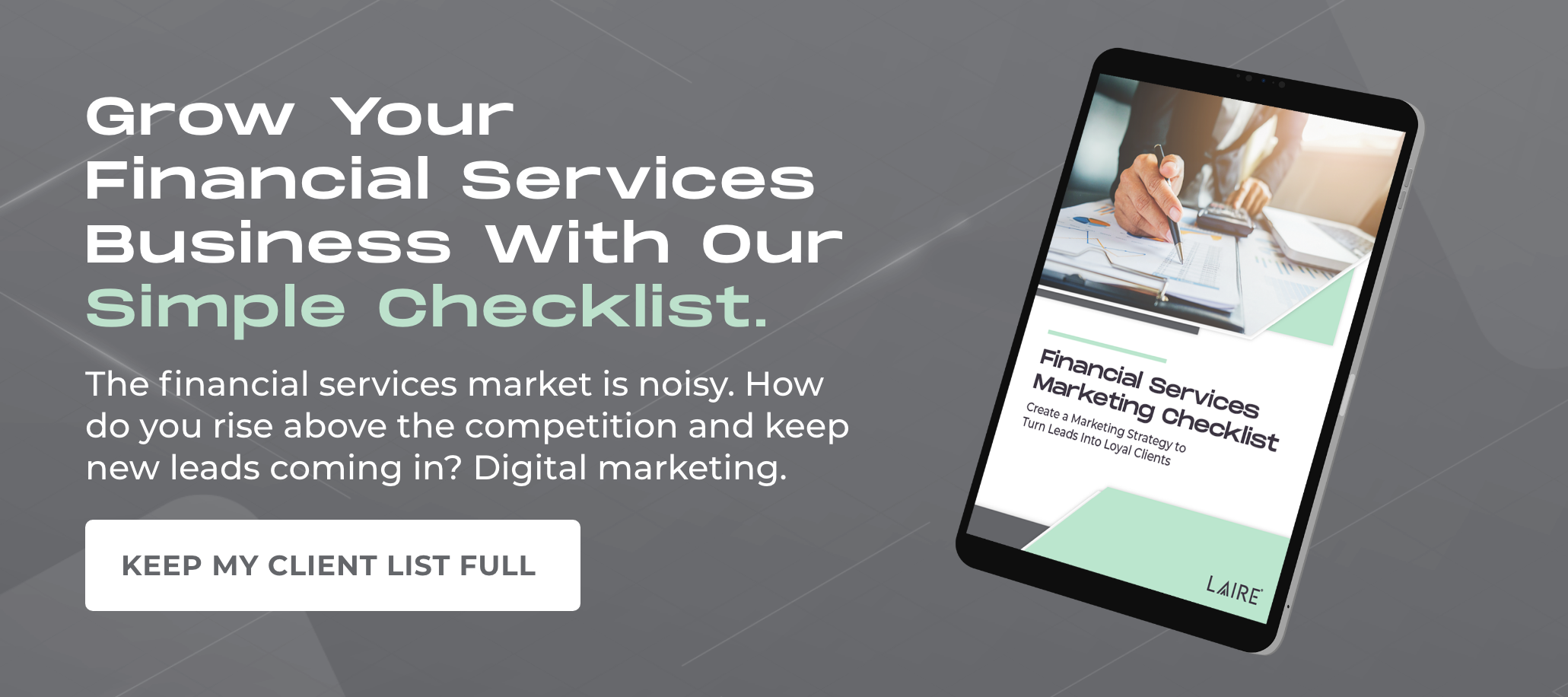Many public accountants find themselves swamped with work from January until April. The tax work seems endless.
Then May hits, and where did everyone go? Of course, tax season's over. You have fewer people needing tax services. But even if you don't see most clients from May to December, what those customers are doing matters — especially if they're interacting with competitors. Chances are good they are. And that impacts you.
You must continue to provide helpful services and information throughout the entire year, not just during the peak of tax season.
With the terabytes of financial knowledge you’ve acquired over the years, sharing even a fraction of it through online content can be an important part of your lead generation and client retention strategies.
When doing content marketing for financial services, you'll focus on your customers’ problems throughout the entirety of the year. This is not only how to increase client retention by showing you’re around for more services; you'll also be able to expand your non-seasonal services to grow your firm.
Your customers will begin to come to you first for important information and answers to their questions so that when tax season does roll around, there's no question about who they choose.
But what kind of content should you create? Financial services content marketing doesn't have to be complicated. Here's where to start building the content side of your inbound marketing plan.
3 Content Ideas to Keep Clients Engaged and Improve Retention
You need content assets to engage your audience, and May to December are naturally fantastic months to put extra focus on content marketing in financial services. Your firm is experiencing fewer deadlines. Now, it's easier to create content for the whole year — including next year’s tax season.
But the kind of content you generate matters. It needs to be timely, relevant, helpful, and engaging to your target customers. This content becomes a magnet online, drawing in prospective customers organically.
Because let's face it. Of course, ads can attract customers. But they're costly and largely disliked. 74% of people feel exhausted when they see too many company ads. Making someone feel tired and agitated isn't the best way to start a professional relationship.

Alternatively, content is helpful. It builds trust, not resentment. Let's get into it.
1. Create an Email Newsletter Worth Your Customers' Time
An email newsletter is a great place for someone in financial services, in particular, to start because you already have the email addresses of your customers from this tax season. And as you continue creating helpful content, you can build that subscriber list.
Email is a fantastic place to:
- Remind former and existing clients of the services you offer
- Stay top of mind
- Boost your client retention rate
- Reassure customers you're available for questions and services
- Nurture leads into paying customers
- Boost referral rates from existing customers
Email newsletters are a great way to inform your current and potential clients about the happenings within your business. But be careful not to make email campaigns seem like endless ads coming into the inbox. That's a surefire way to lose subscribers fast.
Instead, provide useful content that you might have recently released and want to share with them. Financial services have many incredibly effective content formats like:
- Infographics
- Videos
- Opinion pieces
- Case studies
- eBooks/Guides
- Checklists
- Blog posts (more on this one in a bit)
You can enhance the engagement and enjoyment of your emails by adding these. Plus, you can also answer common questions and offer tips for helping clients keep their financials organized all year. Then, next year’s tax season will run more smoothly. That's a win-win!

Emails can include upcoming business functions — such as happy hours, loyalty rewards, referral programs, or new services and discounts.
Make sure that your email is impactful and will be worth the read for your recipients. If your content is not entertaining or does not provide value, you’ll quickly be ignored. That all starts with creating a compelling subject line. Without one, your email may not even get opened, regardless of how outstanding it is.
Your email newsletter is one of several forms of owned media you have at your disposal. Owned media are channels in which you can control the message, timing, and, to some extent, the audience. This is as opposed to earned media like a news story about you or a social media post going viral. You have less control over these.
Owned media is critical to lead generation because it's critical that you reach the right people at the right time with the right message to guide them through the buyer's journey.
By the way, delighted customers write amazing reviews, tell their friends, and provide social proof to others. Simply ask a happy customer to tell their friends, and they'll not hesitate to do it. But email isn't the only owned media you have at your disposal.
2. Ramp Up Your Blog
If you cater to business customers, you naturally have a lot to share on your blog all year long. They have to deal with quarterlies and may have questions about GAAP or the tax implications of certain moves they might make during the year. They may be looking for financing, acquisitions, or accounting services.
But even if you're more on the consumer side of accounting, everyday people want to know throughout the year about how money moves impact taxes and their financial security. Depending on the scope of your financial services, you can offer tips on retirement, government services, and more. Stay top of mind and also take this opportunity to showcase other services.

Business blogs are a great way to become a knowledge hub from which to share relevant information with your audience. When you're creating helpful content on a blog, customers also want to share it with others.
What's more, your blog can be a key resource in explaining your services outside your office. People today do massive research online before even setting up an appointment, so making this available online is critical to obtaining new customers.
On top of that, it's also among your more important client retention strategies. If existing clients don't see information about other services, they may falsely assume you don't offer them — even if you have a service page.
It's simple to generate content ideas for financial services:
- Talk about traditional tax preparations
- Answer why businesses should work with accountants year-round
- Discuss how accountants can help you make large business decisions with financial and tax advice
While you’re focused on customer retention, blogs can also help you appear in the searches that are most important to your firm. Do keyword research to learn the queries people use to find the financial services you offer.
When you create content around those, you can get a keyword boost. This helps you climb the rankings in Google Search to become more visible to new clients. And existing clients see you in their searches more often.
3. Create Nurtures Specific to Your Customers
Thus far, we've discussed types of financial services content in a broader sense. But one type of content, above all others, is vital to improving your client retention rate and acquisition rate. That's relationship nurture content.
Nurtures can be used to promote discounted services, reengage previous contacts, and offer complimentary resources that can answer questions or provide additional guidance. This is an opportunity to showcase your financial services, whatever those might be: lending, financial advising, accounting, or something else.
With that said, this content will be distinctly different depending on whether it's intended for actual clients or potential ones.
One key difference between nurture content for existing clients and potential ones is the "pushiness" level.
While existing customers will tolerate a certain level of direct selling, any whiff of hard sales tactics leads to the abandonment of the prospect's journey to becoming a customer. Instead of actively selling, nurturing content for prospects focuses on providing useful information that furthers the buyer's journey.
Ultimately, that journey leads to you. Your content makes it obvious they need your services without you having to say, "Hey, you must buy this service". But this only happens if you don't damage trust by overselling someone who is still getting to know you.
There are four steps to creating a successful nurture email:
- Offer a piece of relevant content. You'll create a piece of high-value content just for this purpose. It could be an eBook, report, case study, webinar, detailed checklist, etc.
- Remind them about deadlines. Frame this as a friendly and thoughtful reminder. You want to help this contact and don't want them to miss out on this information. A deadline could be tax season, end-of-year, end-of-quarter, new year's resolution, or summer vacation planning.
- Inform them of your services. Let them know you're available to help them and what you could help them with.
- Include a call to action (CTA). For prospect nurturing, use a soft CTA like "schedule a consultation" or "download a resource." The CTA can be more straightforward for an actual client, like "schedule X service."
If you don't already segment your email list to increase relevance, segmenting by prospect or existing customer is a great way to get started. When you create an email for nurturing, design two slightly different versions: one for prospects and the other for current customers. Use email automation to deliver the correct version to each recipient.
As your financial services content marketing progresses, further personalize the customer journey by segmenting based on other qualities like industry, professional versus consumer, or retirement age versus college age. By doing so, you increase the relevance for each recipient.
Thinking Beyond Tax Season: Content Reigns Supreme
Content is the ultimate way to speak to your customers. Having a strong content strategy not only helps you bring in new customers; it also ensures your current customers have a place to find answers to their questions when they aren’t necessarily ready to ask you directly.
With the endless bad financial advice online, you can become a source of truth, accuracy, and staying current. In doing so, you're branding your financial services company. You'll set yourself apart from your more impersonal and unapproachable financial service competitors.
As a financial service provider, learning about financial services content marketing might sound intriguing but intimidating at the same time. We believe that a strong content strategy doesn’t need to be difficult to be effective. In fact, we’ve created blog templates that will help your content keep your customers interested.
Get started with 6 blog templates for winning engagement.


